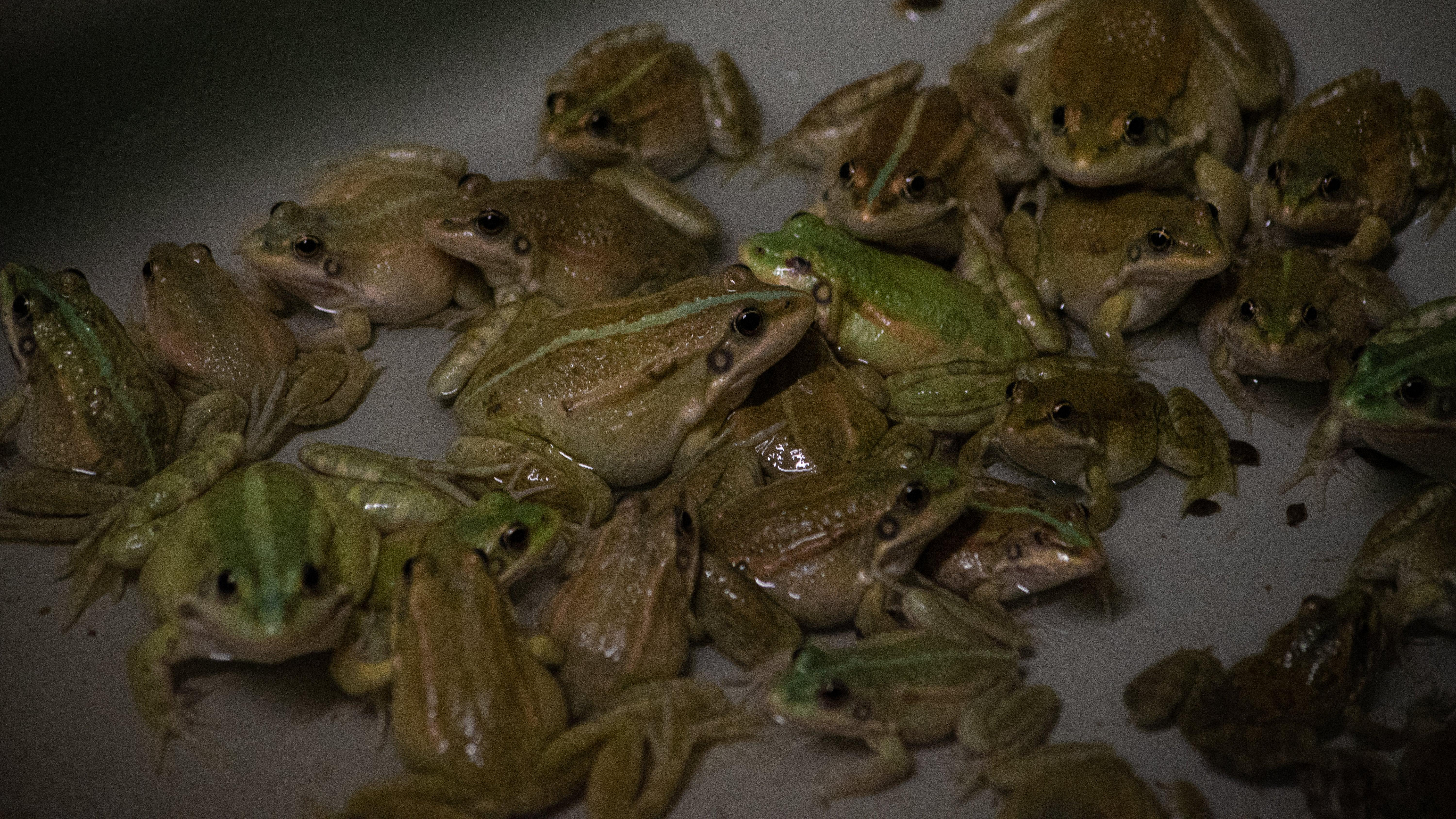A Visit To France's First Frog Farm
Despite being known as French cuisine, frogs' legs are only recently being farmed on French soil.
When thinking about French cuisine, some of the stranger national dishes might pop into your head, like snails or foie gras perhaps. On the more mainstream end of the spectrum, you might think flaky pain au chocolat, crusty baguettes, and cheeses so pungent as to induce joy and vivid nightmares in equal quantities. (I didn't sleep properly for weeks when I first moved to France, and I'm convinced the culprit was camembert.) But no other dish has become as much of a national identity as cuisses de grenouilles, or frogs' legs.
It's still a popular dish: 80 million frogs are consumed annually in France, and for centuries the British have referred to the French as "frogs." That makes it all the more surprising that until just over a decade ago, there wasn't a single frog farm in the country. Frozen frogs' legs were imported from Eastern Europe and Asia to meet demand until in 2010, fish farmer Patrice François decided to hop into a gap into the market and start farming amphibians.
History of frogs’ legs
In spite of their nickname, the French weren't the first to eat frogs' legs. The first consumers were their neighbors across the channel. The British—often called "roast beef" by the French, not, I am told, for our sumptuous Sunday roast dinners but rather for our propensity to cremate our skin like roasting joints of meat when we holiday in France—were in fact the original "froggies." In 2013, an archaeologist on a dig at Stonehenge found toad bones that showed the little creatures had been cooked and eaten in the UK 8,000 years before anywhere recorded in France.
Frogs' legs were introduced into French cuisine in the 12th century by Orthodox monks. During Lent, meat, eggs, and animal byproducts were banned, but seafood permitted. The monks decided that frogs, as amphibians, were closer to fish and could be consumed during Lent. They foraged them from monastery gardens and wetlands which are in abundance in the Auvergne-Rhône-Alpes region of France. Monks were the influencers of their time, so religious peasants emulated them and began to eat frogs too. A national dish was born, and now frogs' legs are considered haute cuisine and served up at the finest of French restaurants.
Visiting the frog farm
On my way to Patrice François's frog farm in Pierrelatte, Auvergne-Rhône-Alpes, I pass monasteries where monks are continuing to influence local cuisine. At Cisternic monastery Notre-Dame d'Aiguebelle, just up the road from the farm, industrious monks produce grenadine and syrups. Further north, in Burgundy, Cîteaux Abbey is known for producing washed-rind cheeses. In the east of the country, a potent green liquor called Chartreuse is brewed using a secret recipe that only a handful of monks are privy to, and sold all over the country.
The son of fish farmers, Patrice has been eating frogs' legs his whole life. His father imported frozen frogs' legs from Turkey. Patrice would look forward to the arrival of spring when he would tuck into frogs' legs from market stalls on light evenings, cooked the traditional way, in butter, parsley, and garlic.
Frustrated by supply chain lapses, Patrice decided to open his own frog farm, France's first. He needed to source fresh, local frogs, but hunting frogs had been outlawed in France in the 1980s. The problem was domesticating frogs to get them to eat dead insects. Frogs eat everything that moves (including each other if they're hungry enough), and supplying enough live insects for an entire frog farm would be a logistical nightmare. And, of course, he didn't want his frogs eating each other. Cannibal frogs would have sounded unappetizing on a restaurant menu, and reduced his output.
Patrice contacted a specialist who had been experimenting with breeding frogs in the Auvergne-Rhône-Alpes. The specialist had recently had a breakthrough and had managed to domesticate frogs to eat inert food after several generations of breeding. Now that these frogs could be classed as domestic animals, Patrice could open his frog farm.
In order not to be competing with cut price frozen frogs' legs imported from Asia, he carved a niche in supplying some of the most prestigious restaurants in the country, notably Restaurant Paul Bocuse in Lyon. Frogs' legs have a high water content, so when frozen, defrosted and cooked they have a tendency to become dry. The fresh kind are juicier. Messy and slathered in butter, they remind me of very pale chicken wings, and with a flavor somewhere between chicken and fish—I can see why monks found them a good replacement for meat.
Patrice shows me around his farm, chilly and damp, like a large pond which must keep the frogs happy. In the first tanks, freckle-sized black tadpoles writhe in the water. At the end, fat, shiny amphibians leapfrog over each other. I'm pleased to see that none of them are eating each other.
With Patrice's market niche, his frogs have the allure of hot cakes. The bulk of his trade comes from high-end restaurants, but he'll sell to locals too if they'll collect. I bump into a mother and her son happily clutching a large case of frogs' legs as I leave. For Patrice, the demand outstrips the supply, though the local monastery isn't amongst his clients.
